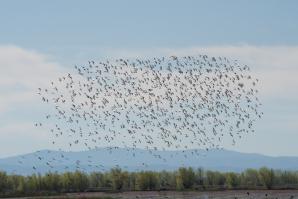Last summer, honey bee hives pollinating orchards in SoCal, from Fresno to Bakersfield, took a hard hit. Eric Mussen, an apiculturist with the UC Cooperative Extension and specialist with the UC Davis Department of Entomology and Nematology, points to tank mixing formulas as the culprit behind what he estimates at over 80,0000 colonies lost. According to Mussen, chemicals often not thought to be harmful to bees can turn deadly when mixed.
Which is why last month’s California Almond Board’s report detailing best practices for protecting honey bees advised almond growers not to use any tank mixing formulas during bloom. Mussen says the report includes sound information and recommendations, but it won’t mean much for the bees’ survival if not implemented by the broader agricultural community, not just almond growers.
“This message has to reach and impact individuals like pest control advisors, who decide what chemicals will be used and in what manner, if this effort is to prove effective,” Mussen says.
Valeri Strachan-Severson oversees some 11,000 hives at Strachan Apiaries. This year, the hives she put on sunflowers near corn crops came back weak.
“I believe the GMO corn affected those colonies, so I’m doubtful I’ll do summer pollination in the future,” she says.
While Strachan-Severson believes cooperation between apiarists and growers is a step in the right direction, she says there must be an increased emphasis on protecting honey bees prior to bloom and more attention paid to how pesticides are regulated on nearby orchards.
“It is getting more difficult to keep the bees alive,” she says. “And I don’t have answers.”
Learn more about the plight of honey bees, and keepers like Strachan-Severson, in Allison Joy’s November feature, “As the Bees Go.” Sign up for our newsletter, and we’ll let you know when it’s available online.
Recommended For You

Water Foul
The drought is putting in jeopardy efforts to shore up migratory bird populations
Doug Thomas stops his white pickup along the elevated dirt road that carves through the acres of newly planted rice stalks in Wheatland, Calif.
In this scene, replete with a myriad of migratory birds lazily grazing in the green fields, change is soon to come. The landscape, Thomas says, will be transformed into an oasis for waterfowl and shorebirds that will find a man-made wetlands to call home on their annual migration this fall.

Healthy Options
Farmers markets and urban growers combat local food deserts
Despite living near some of the most productive farmland on earth, many Sacramentans are unable to find produce that’s both fresh and affordable in their own neighborhoods.

Touchscreen to Table
West Sacramento to address food access with Code for America
Code for America works with cities around the country, using open-source software to improve the scalability and reach of government services. Starting next year, Code for America fellows will work with the Sacramento Area Council of Governments and the city of West Sacramento using technology to tackle issues related to health care and food access in the city.

DMV for Cows?
iPads to beef up California’s cattle inspection process
If you’re one of those motorists who describe the whole DMV experience as slow, torturous and/or dystopian, consider the cow.




Comments
A "new" piece of information seems to come up on the reason behind colony collapse in bees every year, yet 95% of commercial farmers (and mind you, plenty of scientists) still insist that pesticides are not why the bees population is in decline. The ignorance, unfortunately, doesn't end there. I'm employed at a pest control company in London and surely enough, we get monthly calls from clients asking us to exterminate bees on their property and remove their nests. We're forced to explain that bees aren't pests, a bee population is not an infestation and removing it is NOT pest control. We even got to the point where we had to create an entire page on our pest control website about bees, explaining why we didn't offer the service - and why, in fact, no one does.
James Norton, Consultant at London pest control http://www.fantasticpestcontro...
Great information in pertaining to this pest control service problems of the pests. It is nice to find a blog like this that give some important ways to prevent and to treat them.
Pest Control Services in London
Good information about pest problem and the pest control services. http://www.npcs.co.uk/
Although there is good reason to remain concerned about the plight of the bees we may also have hope that our increasing awareness of the environmental damage caused by use of harsh pesticides will prevail. Although some may feel that it is too early to be this optimistic there have been signs that the reduction in the use of pesticides has contributed to a recovery in the number of cockchafers (May bugs) whose population was decimated in the 20th century.
http://www.cleankill.co.uk/blo...